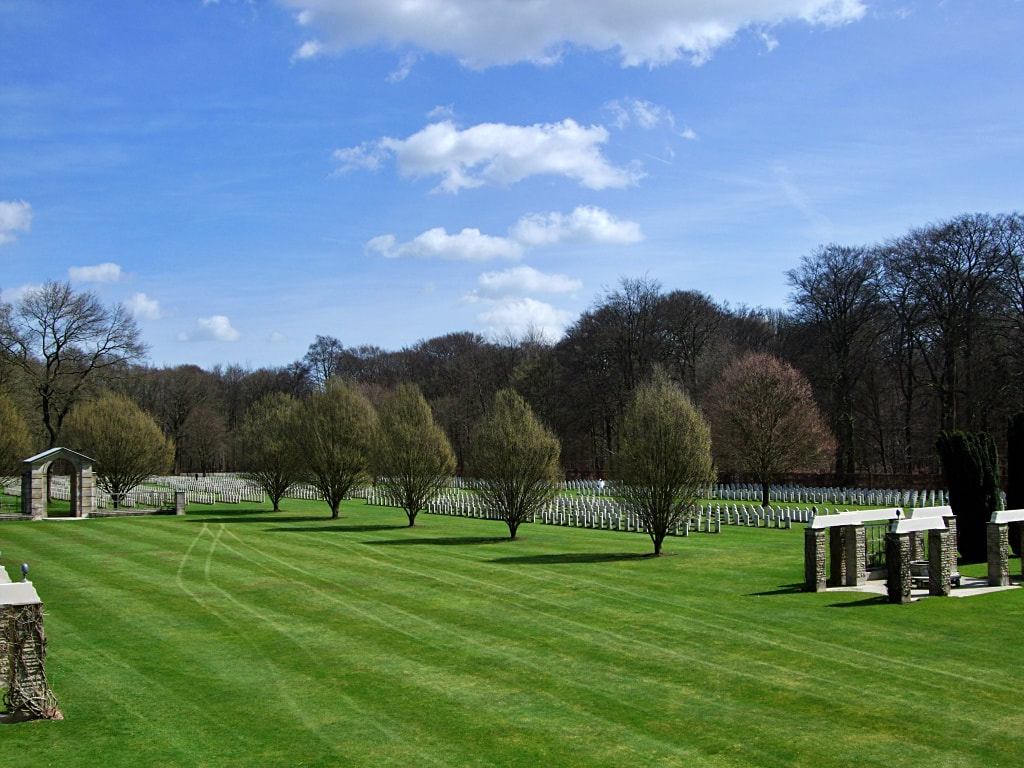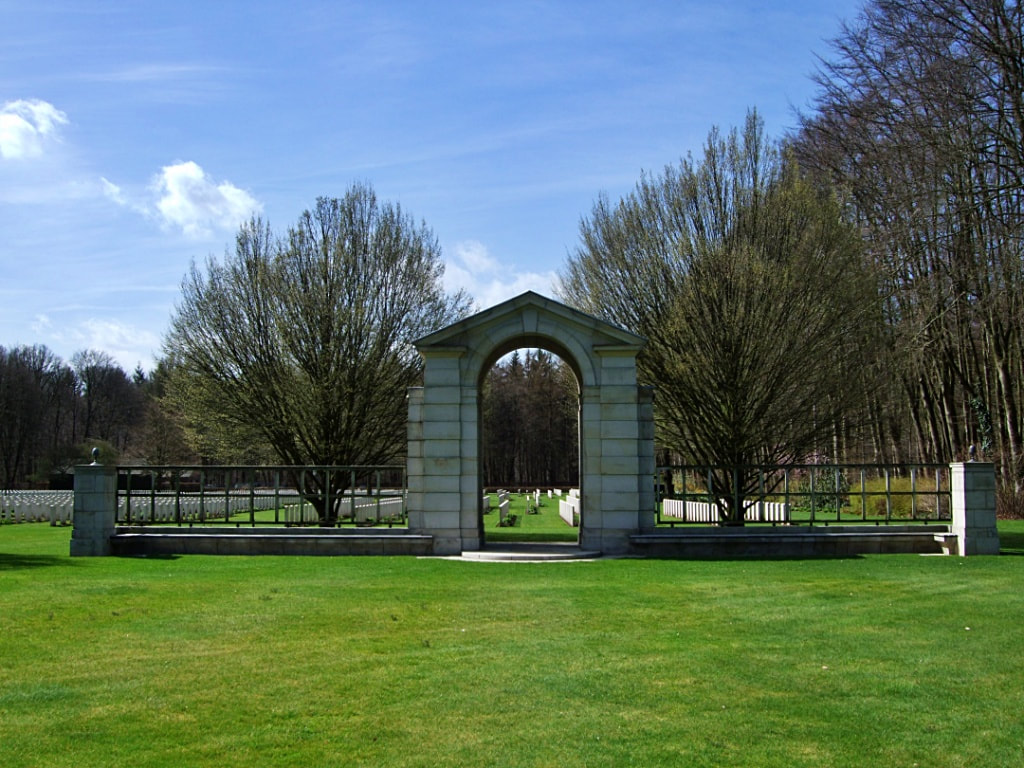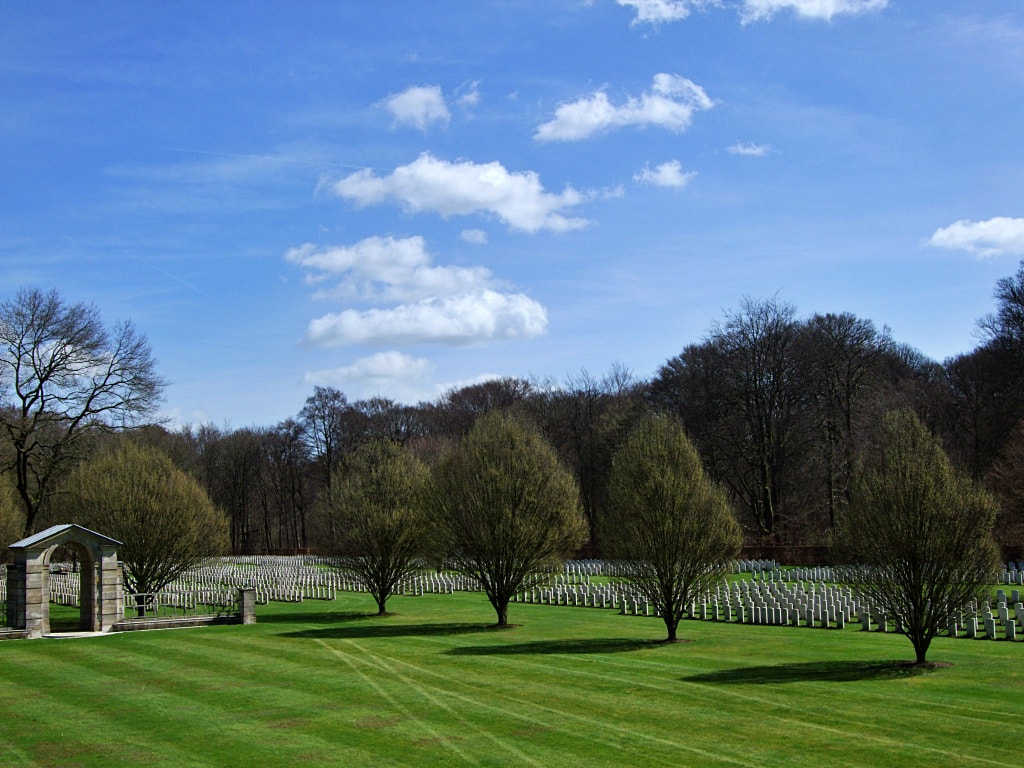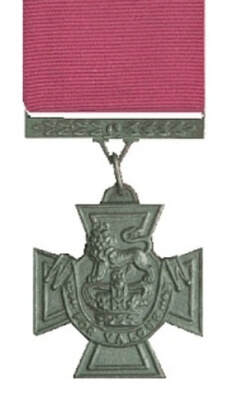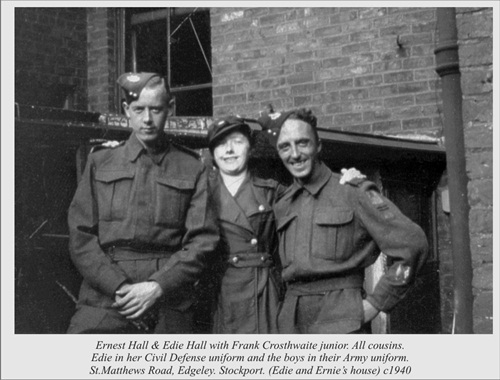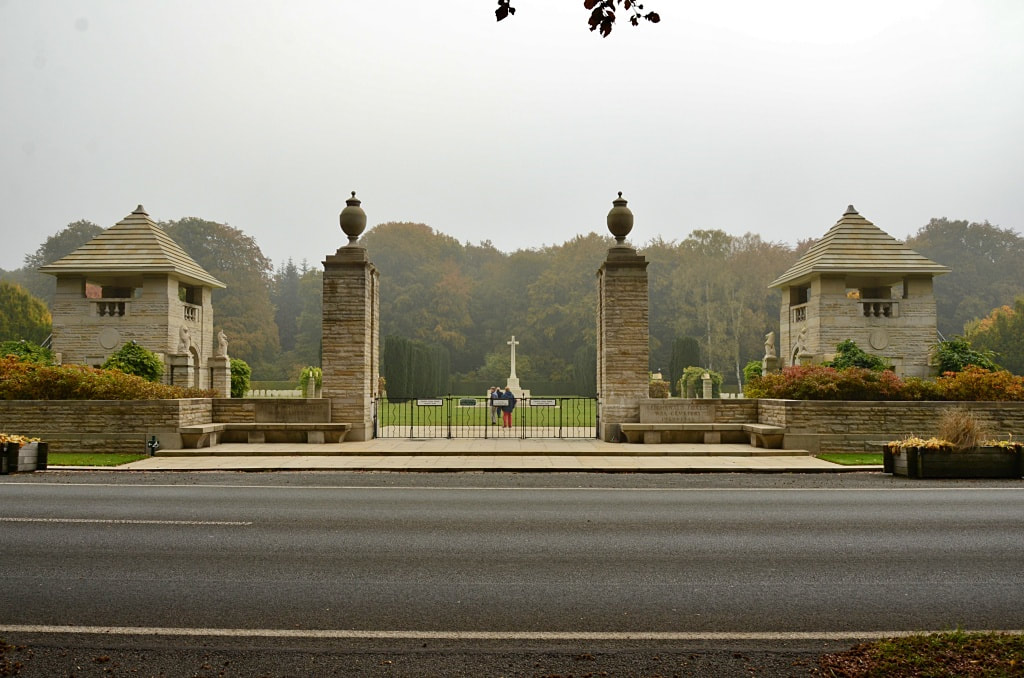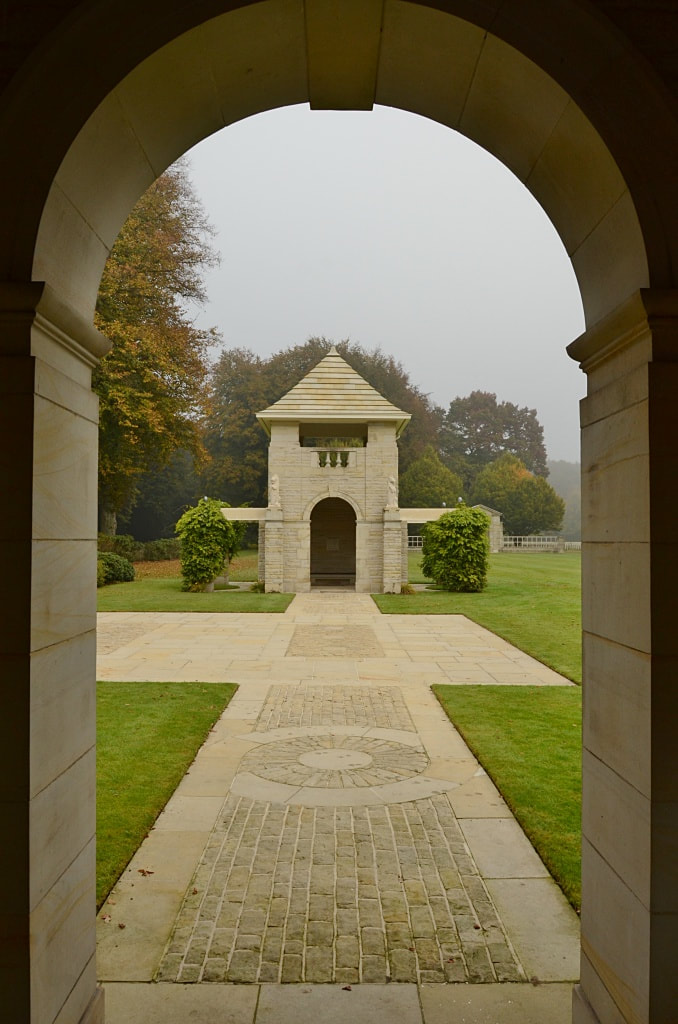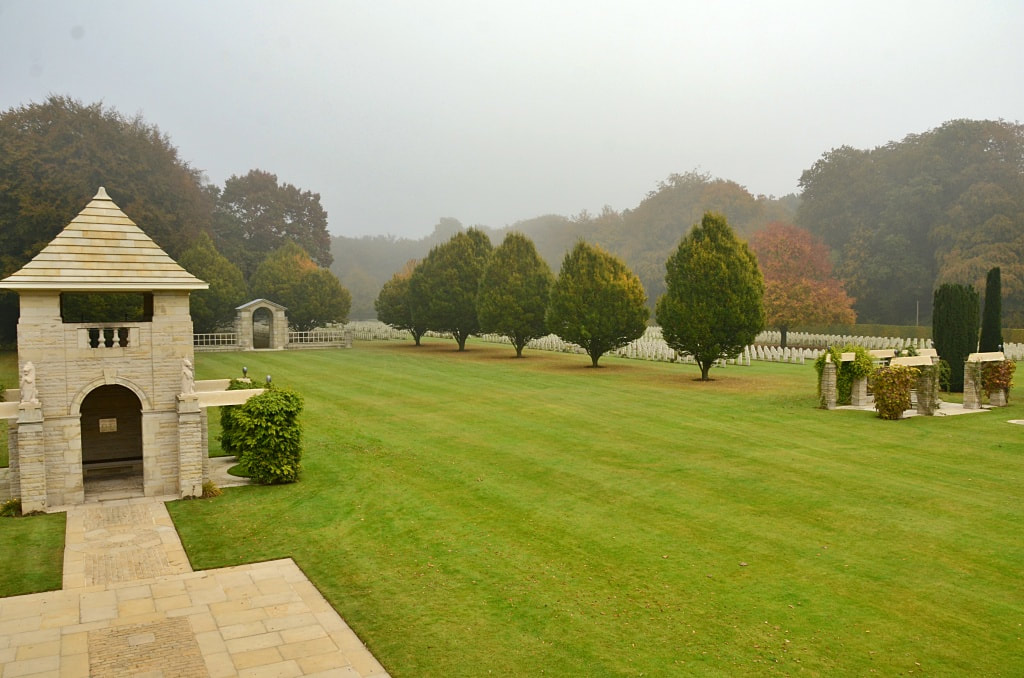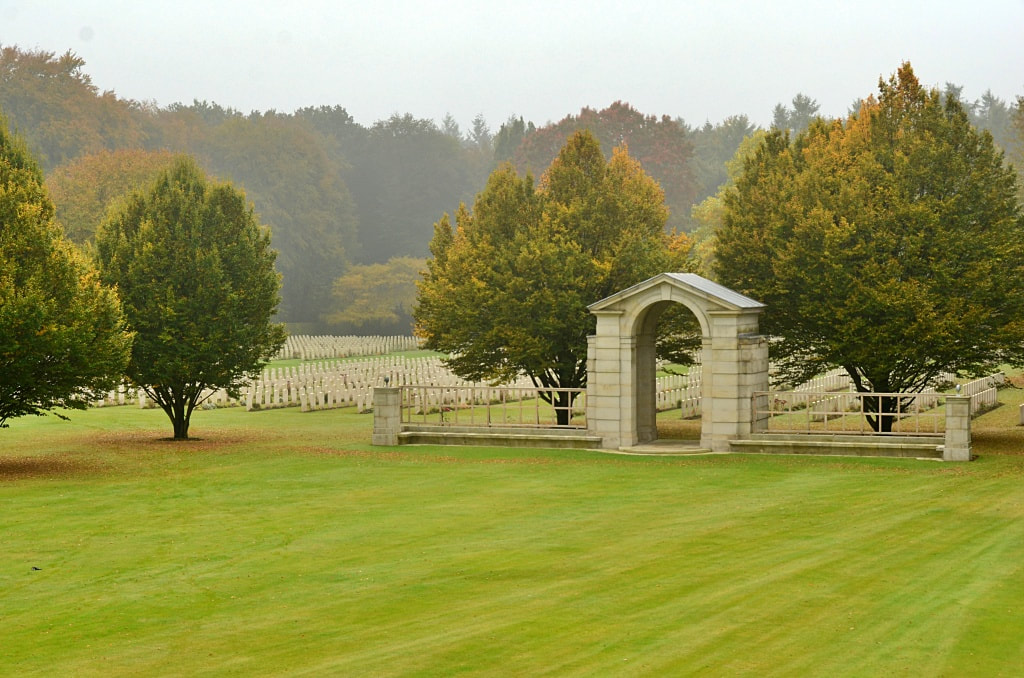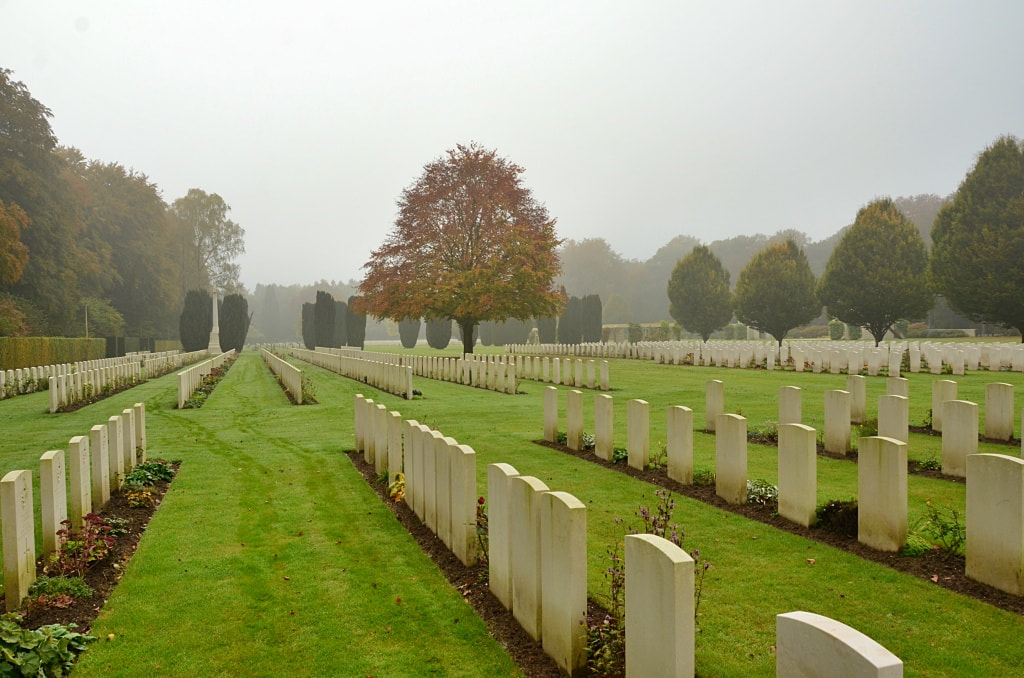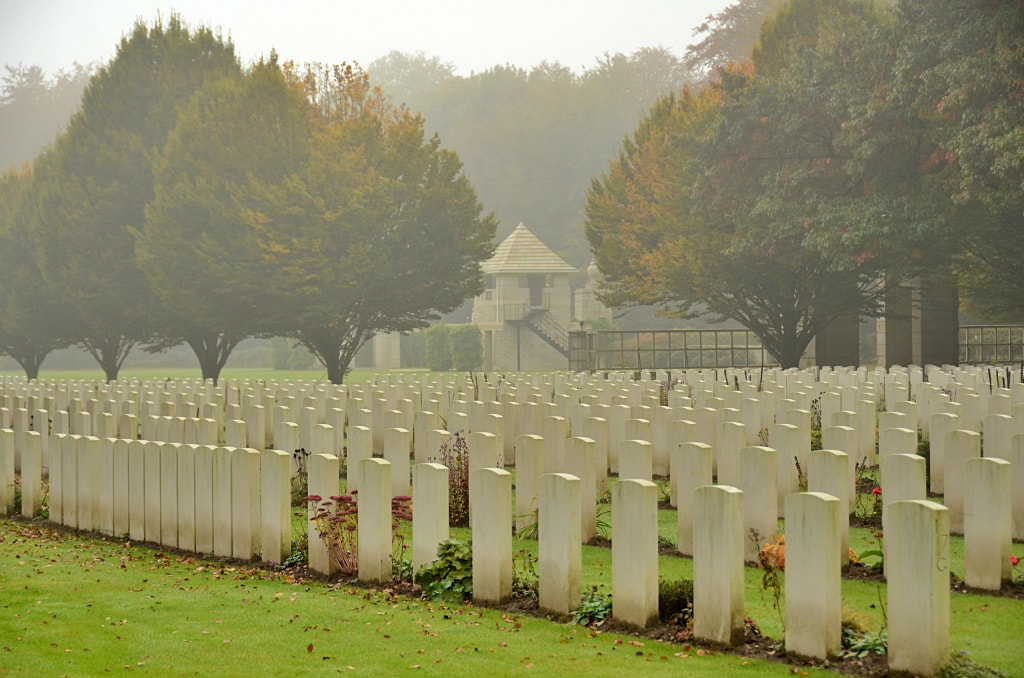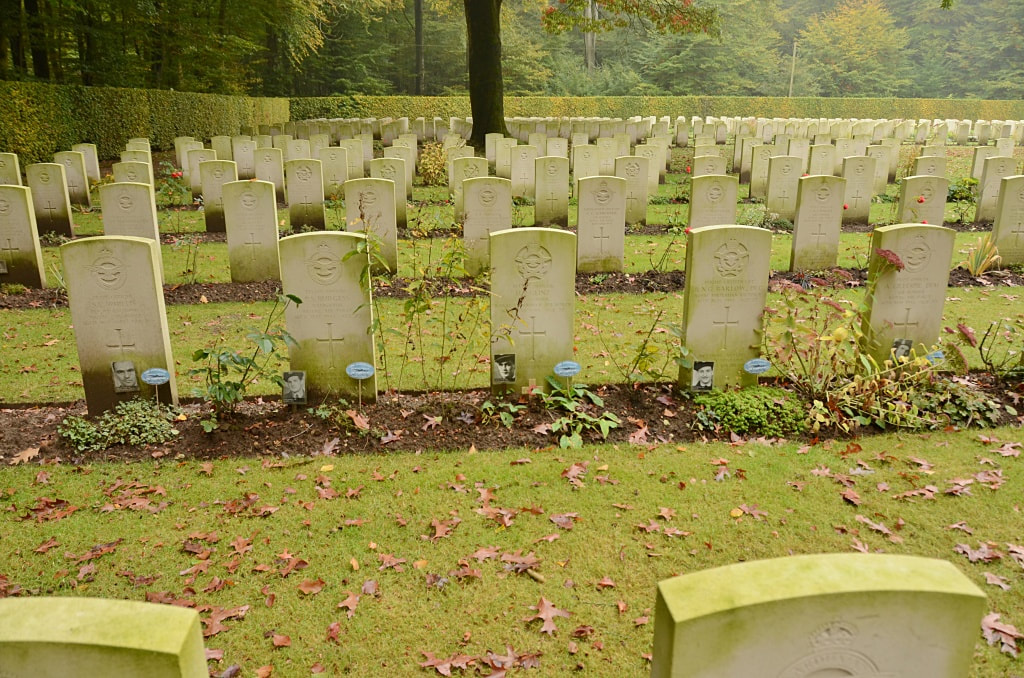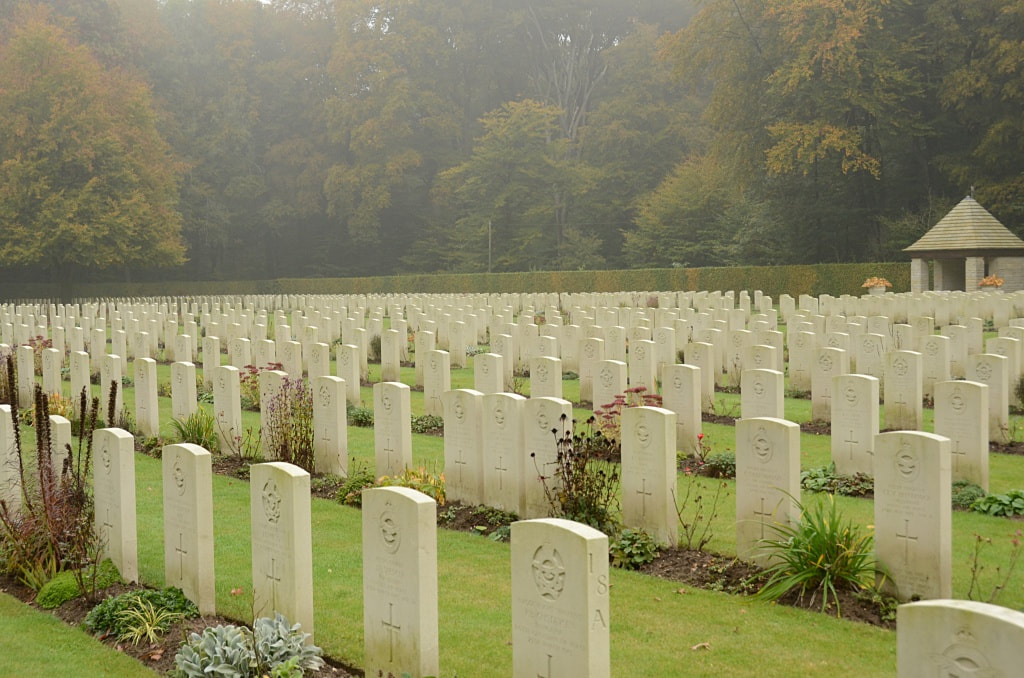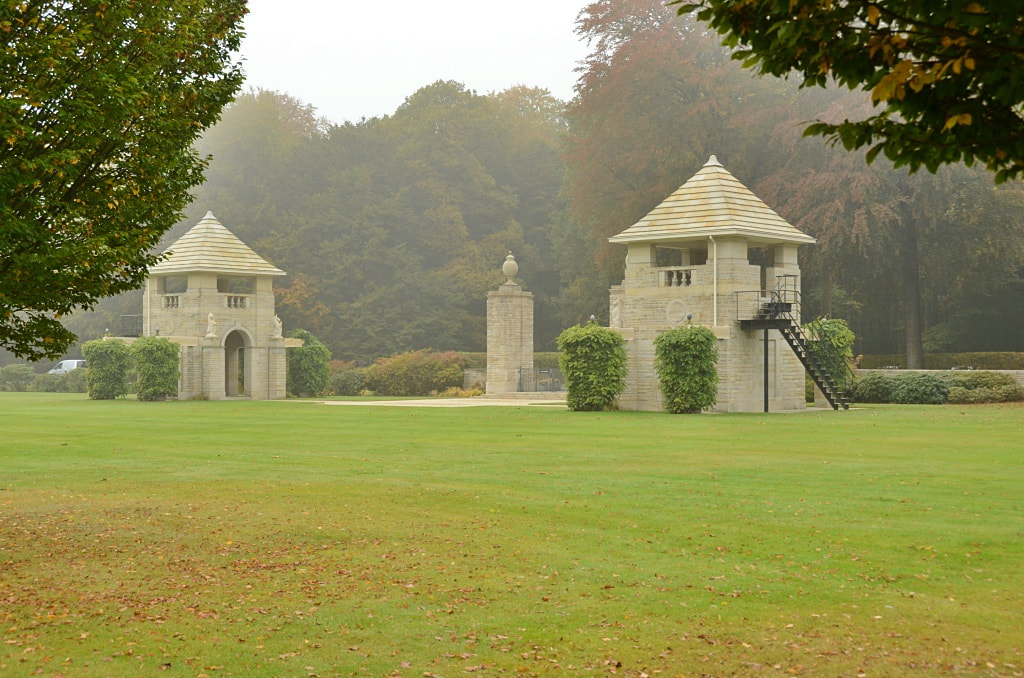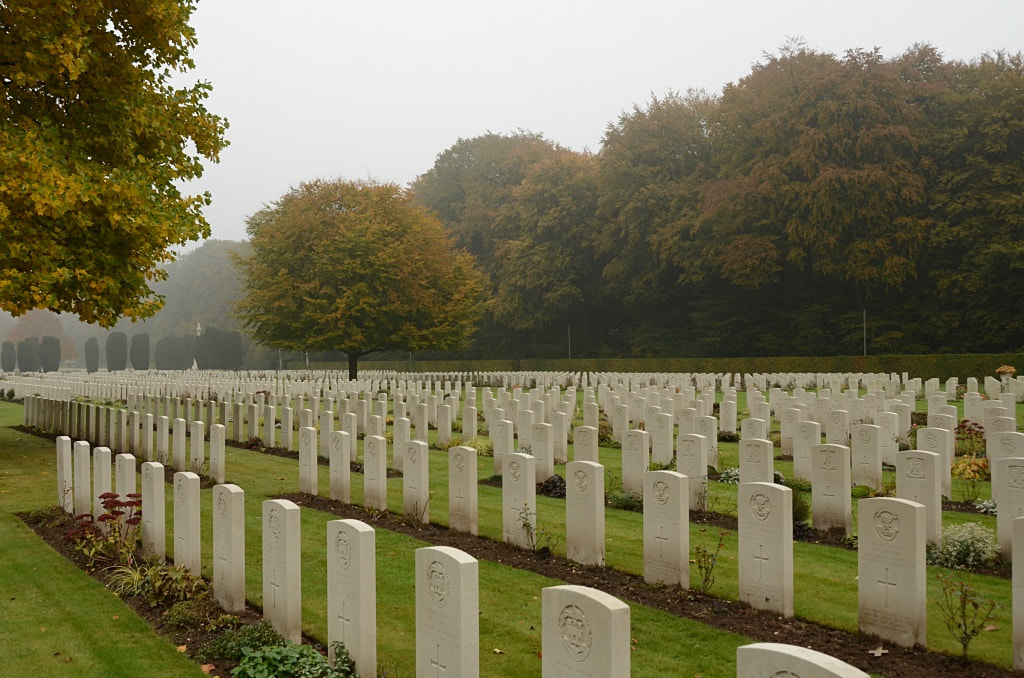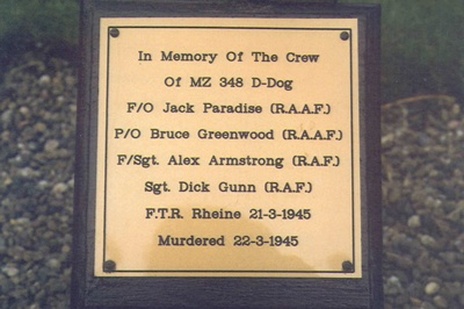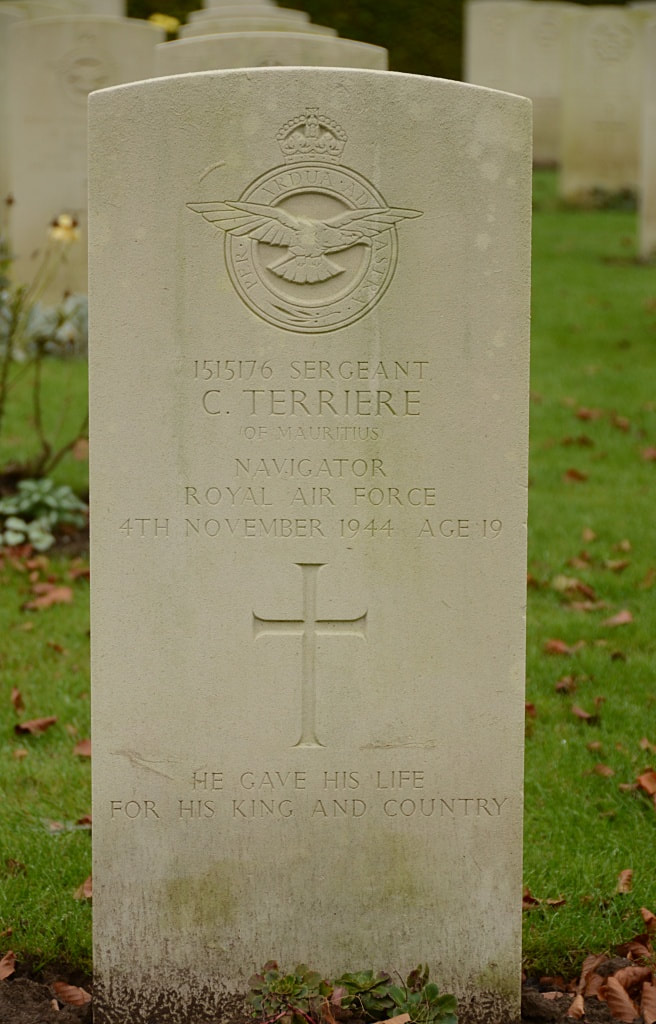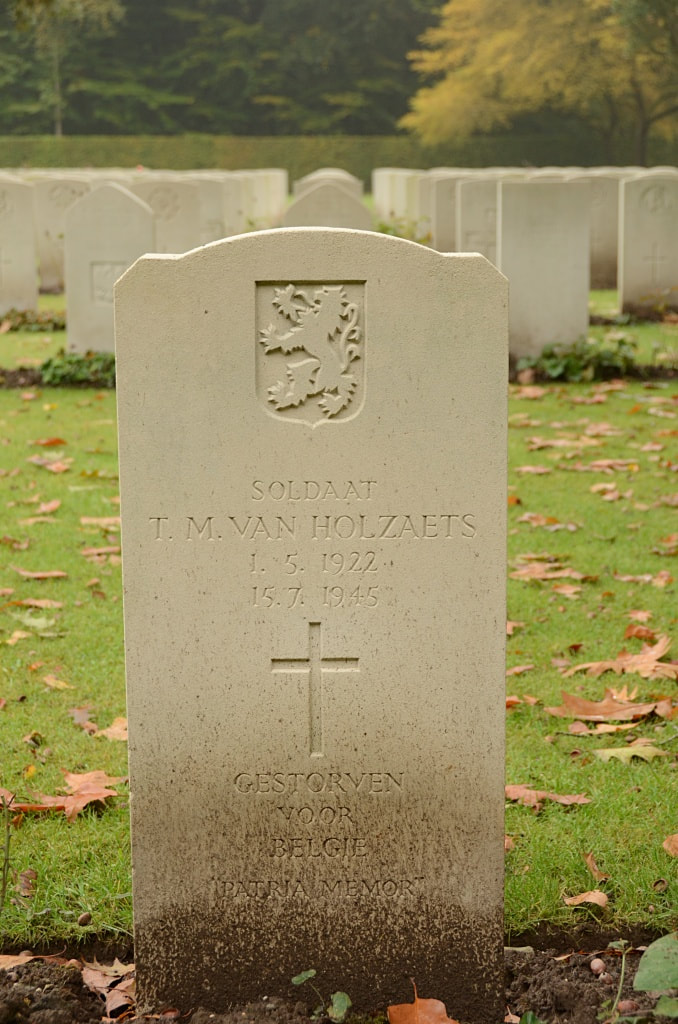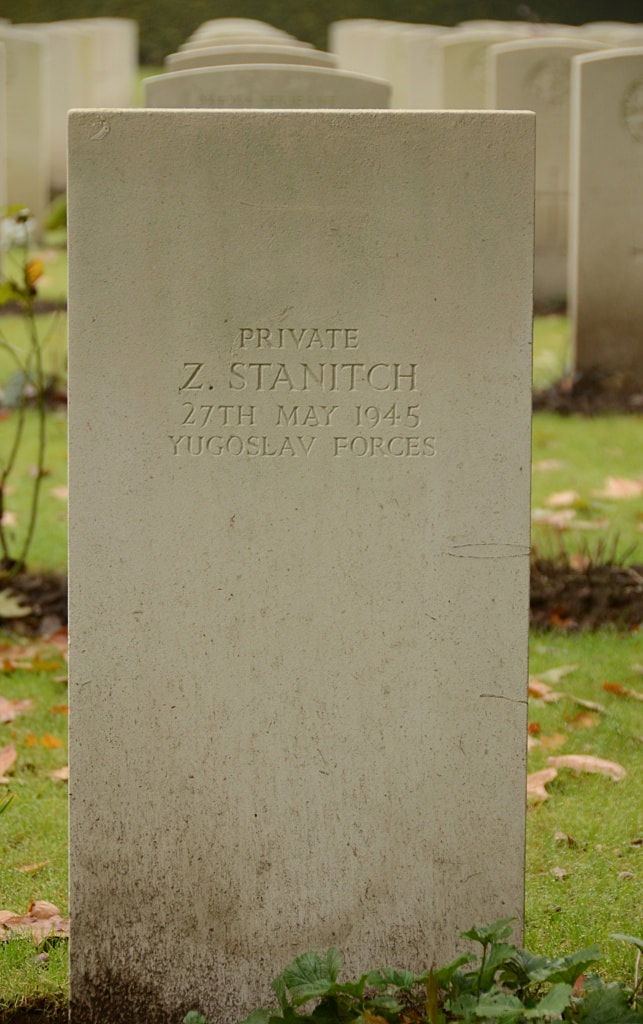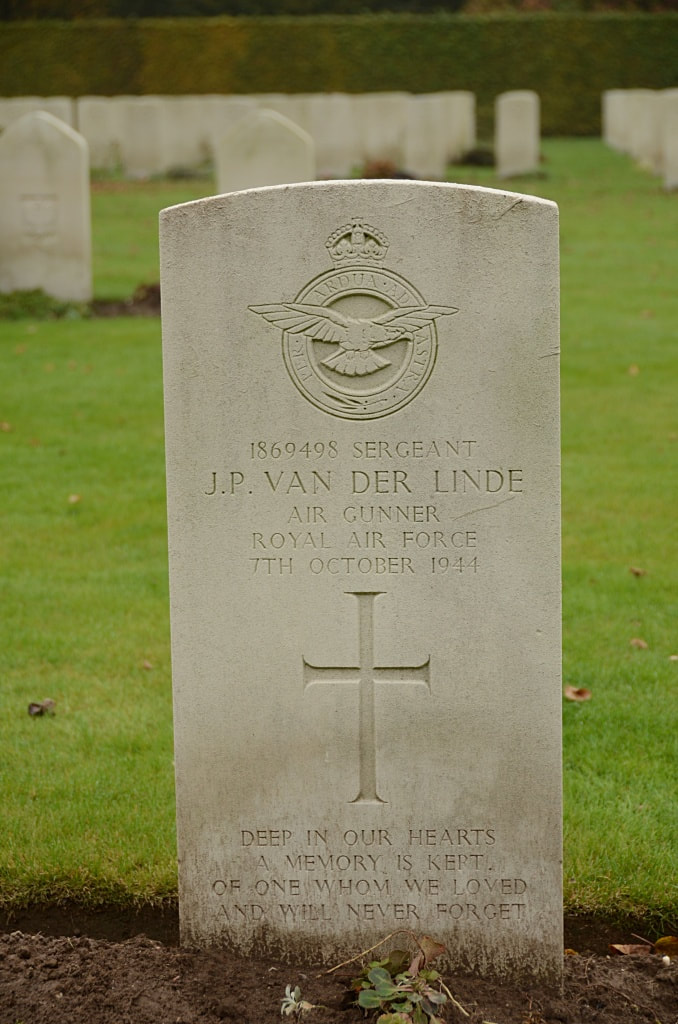REICHSWALD FOREST WAR CEMETERY
Nordrhein-Westfalen
Germany
GPS Coordinates: Latitude: 51.74094, Longitude: 6.08179
Location Information
The town of Kleve lies in the west of Germany close to the Dutch border, approx 130kms to the north west of Koln, and approx 25kms to the south east of Nijmegen. NB: Kleve has an airport but Dusseldorf (Weeze) airport is closer.
From the A57 motorway Koln to Goch take exit 2 (Ausfahrt 2) KLEVE / GOCH-WEST and follow the signs for KLEVE.
After approx 2kms turn left onto the B504 and follow the direction KRANENBURG. Continue for approx 7kms and then turn right (CWGC sign) onto the GRUNEWALDSTRASSE, direction KLEVE . Continue for approx 3.5kms and Reichswald Forest War cemetery can be found on the right.
The cemetery address is:-
Grunewaldstrasse
47533 Kleve
Germany
Visiting Information
This cemetery is at all times open to the public and can be visited from sunrise to sunset.
Visitors should be aware that the parking area is on the opposite side of a busy road and care should be taken when crossing.
Wheelchair access to the cemetery is possible via the main entrance.
Historical Information
Reichswald Forest War Cemetery was created after the Second World War when burials were brought in from all over western Germany and is the largest Commonwealth cemetery in the country.
Some of those members of the land forces buried there died in the advance through Reichswald Forest in February 1945. Others died crossing the Rhine, among them members of the airborne forces whose bodies were brought from Hamminkeln, where landings were made by the 6th Airborne Division from bases in England.
Some of the airmen buried in the cemetery lost their lives in supporting the advance into Germany, but most died earlier in the war in the intensive air attacks over Germany. Their graves were brought in from cemeteries and isolated sites in the surrounding area.
There are now 7,594 Commonwealth servicemen of the Second World War buried or commemorated in the cemetery. 176 of the burials are unidentified. There are also 78 war graves of other nationalities, most of them Polish.
Special Memorials to 9 airmen are located at the East boundary wall, near Plot 10. Further Special Memorials to 7 airmen are located within Plot 31, near the Cross of Sacrifice.
The cemetery was designed by Philip Hepworth.
Total Burials: 7,641.
World War Two Identified Casualties: United Kingdom 6,218, Canada 705, Australia 327, New Zealand 127, Poland 72, Belgium 1, Netherlands 1, Norway 1, South Africa 1, U. S. A. 1. Total 7,454.
The town of Kleve lies in the west of Germany close to the Dutch border, approx 130kms to the north west of Koln, and approx 25kms to the south east of Nijmegen. NB: Kleve has an airport but Dusseldorf (Weeze) airport is closer.
From the A57 motorway Koln to Goch take exit 2 (Ausfahrt 2) KLEVE / GOCH-WEST and follow the signs for KLEVE.
After approx 2kms turn left onto the B504 and follow the direction KRANENBURG. Continue for approx 7kms and then turn right (CWGC sign) onto the GRUNEWALDSTRASSE, direction KLEVE . Continue for approx 3.5kms and Reichswald Forest War cemetery can be found on the right.
The cemetery address is:-
Grunewaldstrasse
47533 Kleve
Germany
Visiting Information
This cemetery is at all times open to the public and can be visited from sunrise to sunset.
Visitors should be aware that the parking area is on the opposite side of a busy road and care should be taken when crossing.
Wheelchair access to the cemetery is possible via the main entrance.
Historical Information
Reichswald Forest War Cemetery was created after the Second World War when burials were brought in from all over western Germany and is the largest Commonwealth cemetery in the country.
Some of those members of the land forces buried there died in the advance through Reichswald Forest in February 1945. Others died crossing the Rhine, among them members of the airborne forces whose bodies were brought from Hamminkeln, where landings were made by the 6th Airborne Division from bases in England.
Some of the airmen buried in the cemetery lost their lives in supporting the advance into Germany, but most died earlier in the war in the intensive air attacks over Germany. Their graves were brought in from cemeteries and isolated sites in the surrounding area.
There are now 7,594 Commonwealth servicemen of the Second World War buried or commemorated in the cemetery. 176 of the burials are unidentified. There are also 78 war graves of other nationalities, most of them Polish.
Special Memorials to 9 airmen are located at the East boundary wall, near Plot 10. Further Special Memorials to 7 airmen are located within Plot 31, near the Cross of Sacrifice.
The cemetery was designed by Philip Hepworth.
Total Burials: 7,641.
World War Two Identified Casualties: United Kingdom 6,218, Canada 705, Australia 327, New Zealand 127, Poland 72, Belgium 1, Netherlands 1, Norway 1, South Africa 1, U. S. A. 1. Total 7,454.
1592376 Private James Stokes V. C.
2nd Bn. King's Shropshire Light Infantry
1st March 1945, aged 30.
Plot 62 E. 14.
Citation:
The citation in the London Gazette for 13th April, 1945, contains the following details: In Holland, on 1st March, 1945, during an attack on Kerbenheim, Private Stokes was a member of the leading section of a platoon pinned down by heavy fire from a farm building. Without waiting for orders Private Stokes dashed through the enemy fire, to disappear inside this building. The fire stopped, and he reappeared, wounded in the neck. This valiant action enabled the platoon to advance to the next objective. Private Stokes was ordered back to a Regimental Aid Post, but refused to go. The platoon then encountered heavy fire from a house on the left. Again without waiting for orders, Private Stokes rushed the house by himself and all firing from it ceased. His gallantry enabled his platoon, which he subsequently rejoined bringing five prisoners, to continue the advance. In the final assault Private Stokes, now severely wounded, once more dashed to the objective through intense fire. He finally fell, firing his rifle to the last. It was found that he had been wounded eight times in the upper part of the body. Private Stokes's one object throughout this action was to kill the enemy, at whatever personal risk. His magnificent courage, devotion to duty, and splendid example inspired all around him, and ensured the success of the attack at a critical moment; moreover, his self-sacrifice saved his Platoon and Company heavy casualties.
2nd Bn. King's Shropshire Light Infantry
1st March 1945, aged 30.
Plot 62 E. 14.
Citation:
The citation in the London Gazette for 13th April, 1945, contains the following details: In Holland, on 1st March, 1945, during an attack on Kerbenheim, Private Stokes was a member of the leading section of a platoon pinned down by heavy fire from a farm building. Without waiting for orders Private Stokes dashed through the enemy fire, to disappear inside this building. The fire stopped, and he reappeared, wounded in the neck. This valiant action enabled the platoon to advance to the next objective. Private Stokes was ordered back to a Regimental Aid Post, but refused to go. The platoon then encountered heavy fire from a house on the left. Again without waiting for orders, Private Stokes rushed the house by himself and all firing from it ceased. His gallantry enabled his platoon, which he subsequently rejoined bringing five prisoners, to continue the advance. In the final assault Private Stokes, now severely wounded, once more dashed to the objective through intense fire. He finally fell, firing his rifle to the last. It was found that he had been wounded eight times in the upper part of the body. Private Stokes's one object throughout this action was to kill the enemy, at whatever personal risk. His magnificent courage, devotion to duty, and splendid example inspired all around him, and ensured the success of the attack at a critical moment; moreover, his self-sacrifice saved his Platoon and Company heavy casualties.
Headstone
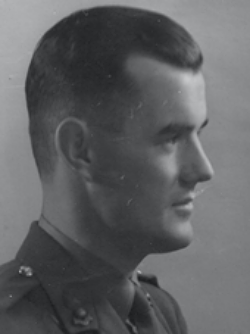
314709 Lieutenant
Thomas Carey
Welch Regiment
1st April 1945, aged 26.
Plot 50. D. 18.
Son of Thomas Martin Carey and Jane Carey, of Rhos-on-Sea, Denbighshire.
Photo supplied by Thomas's nephew, Chris Kennedy
Thomas Carey
Welch Regiment
1st April 1945, aged 26.
Plot 50. D. 18.
Son of Thomas Martin Carey and Jane Carey, of Rhos-on-Sea, Denbighshire.
Photo supplied by Thomas's nephew, Chris Kennedy

T/5508263 Driver
Albert Carter
Royal Army Service Corps.
27th March 1945, aged 31.
Plot 48. A. 17
Son of Albert and Helen Carter; husband of Elsie Carter, of Bransgore, Hampshire.
Picture courtesy of daughter, Susan Pateman (nee Carter)
Albert Carter
Royal Army Service Corps.
27th March 1945, aged 31.
Plot 48. A. 17
Son of Albert and Helen Carter; husband of Elsie Carter, of Bransgore, Hampshire.
Picture courtesy of daughter, Susan Pateman (nee Carter)

5050183 Corporal
Leonard Doney
Wiltshire Regiment
08th March 1945 aged 25.
Plot 57.E.17
Son of William & Agnes Doney of Burton upon Trent.
Remembered and Never Forgotten by niece Suzanne Insley
Leonard Doney
Wiltshire Regiment
08th March 1945 aged 25.
Plot 57.E.17
Son of William & Agnes Doney of Burton upon Trent.
Remembered and Never Forgotten by niece Suzanne Insley
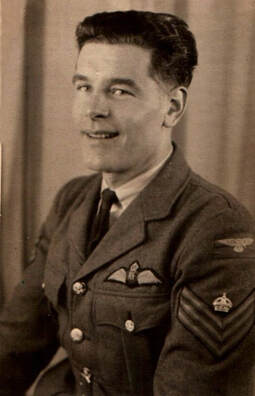
184671 Pilot Officer
Cornelius George Draper
Pilot in 153 Squadron, (Bomber Command), Royal Air Force Volunteer Reserve.
14th October 1944, aged 30.
Shot down over Duisburg, Germany
Son of Cornelius George and Dorothy Draper, of Hull; husband of Kathleen Frances Draper, of Hull.
Picture courtesy of Carol Broughton
Cornelius George Draper
Pilot in 153 Squadron, (Bomber Command), Royal Air Force Volunteer Reserve.
14th October 1944, aged 30.
Shot down over Duisburg, Germany
Son of Cornelius George and Dorothy Draper, of Hull; husband of Kathleen Frances Draper, of Hull.
Picture courtesy of Carol Broughton
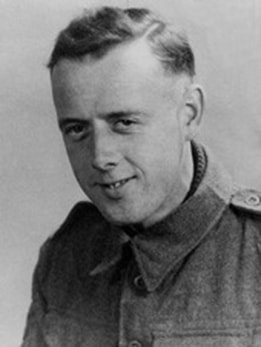
3602590 Lance Corporal
Ernest Hall
9th Bn. Durham Light Infantry
4th April 1945, aged 28.
Plot 55. B. 14.
Pictures courtesy of Dave Moran
Ernest Hall
9th Bn. Durham Light Infantry
4th April 1945, aged 28.
Plot 55. B. 14.
Pictures courtesy of Dave Moran

J26610 Pilot Officer
Griffith Lewis Hughes
Air Gunner in 78 (R.A.F.) Squadron
Royal Canadian Air Force
9th October 1943, aged 21.
Plot 29. A. 15.
Son of Thomas and Blodwen Lloyd Hughes, of Vancouver, British Columbia, Canada.
Shot down near Hanover Germany, October 9, 1943
Picture courtesy of Marianne Wells
Griffith Lewis Hughes
Air Gunner in 78 (R.A.F.) Squadron
Royal Canadian Air Force
9th October 1943, aged 21.
Plot 29. A. 15.
Son of Thomas and Blodwen Lloyd Hughes, of Vancouver, British Columbia, Canada.
Shot down near Hanover Germany, October 9, 1943
Picture courtesy of Marianne Wells

14585035 Lance Bombardier
Edward Johnson
Royal Artillery, 53 (The Worcestershire Yeomanry) Airlanding Lt. Regt.
24th March 1945, aged 29 in Operation Varsity.
Plot 42. A. 3.
Son of Edward and Cecilia Johnson, of Liverpool. Husband of Daisy Johnson, of Orrell Park, Liverpool and father to Keith. Brother to Douglas and Alan.
'Lost Awhile Our Treasured Love, Gained Forever, Safe Above'
Picture and text courtesy of Keith Johnson (Son)
Edward Johnson
Royal Artillery, 53 (The Worcestershire Yeomanry) Airlanding Lt. Regt.
24th March 1945, aged 29 in Operation Varsity.
Plot 42. A. 3.
Son of Edward and Cecilia Johnson, of Liverpool. Husband of Daisy Johnson, of Orrell Park, Liverpool and father to Keith. Brother to Douglas and Alan.
'Lost Awhile Our Treasured Love, Gained Forever, Safe Above'
Picture and text courtesy of Keith Johnson (Son)

308214 Lieutenant
Ian Hendry Mackay
7th Battalion, Cameronians (Scottish Rifles)
15th March 1945 aged 20.
Plot 49. A. 13.
Son of James and Evelyn Gertrude Elizabeth MacKay, of Hale, Lancashire.
Picture courtesy of Nicholas Mc Kay
Ian Hendry Mackay
7th Battalion, Cameronians (Scottish Rifles)
15th March 1945 aged 20.
Plot 49. A. 13.
Son of James and Evelyn Gertrude Elizabeth MacKay, of Hale, Lancashire.
Picture courtesy of Nicholas Mc Kay
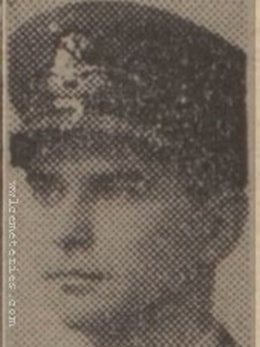
42084 Flight Lieutenant
Arnold John Strachan
Pilot in 151 Squadron, Royal Air Force (RAFO)
10th November 1940, aged 30.
Plot 31. G. 15.
Son of Douglas Walter and Annie Elizabeth Strachan, of Hull.
Arnold John Strachan
Pilot in 151 Squadron, Royal Air Force (RAFO)
10th November 1940, aged 30.
Plot 31. G. 15.
Son of Douglas Walter and Annie Elizabeth Strachan, of Hull.
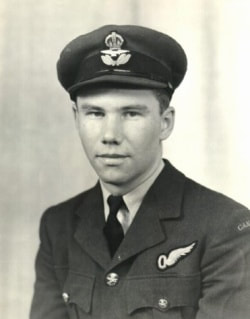
J/16688 Flight Lieutenant
Torger Harlo Taerum
617 Squadron, Royal Canadian Air Force
16th September 1943.
Collective Grave 16. B. 13-16.
Son of Guttorm Tonger and Hilda Ingeline Olson Taerum, of Calgary, Alberta.
Brother of Lorne Clifford Taerum who died on February 3, 1945 while serving with the Royal Canadian Air Force. He is buried in Oploo (Westerbeek) Roman Catholic Cemetery
Torger took part in the Dambuster raid on the Möhne Dam on the night of the 16th-17th May 1943.
Torger Harlo Taerum
617 Squadron, Royal Canadian Air Force
16th September 1943.
Collective Grave 16. B. 13-16.
Son of Guttorm Tonger and Hilda Ingeline Olson Taerum, of Calgary, Alberta.
Brother of Lorne Clifford Taerum who died on February 3, 1945 while serving with the Royal Canadian Air Force. He is buried in Oploo (Westerbeek) Roman Catholic Cemetery
Torger took part in the Dambuster raid on the Möhne Dam on the night of the 16th-17th May 1943.
The image on the left is the original grave marker and the image on the right is a Group photo of Guy Gibson V. C. in Centre, and Torger (Terry) on the right.
Images in gallery below © Johan Pauwels
The Dreierwalde Case
(All pictures and text by Ken Wright)
Dreierwalde was the site of a German fighter airfield situated between the villages of Hopsten and Dreierwalde near Rheine in Westphalia. It was the home base of JG 27 [Jagdgruppe-Fighter Group] The Commanding Officer at the time was Major Karl Rauer, while his adjutant and deputy commanding officer was Hauptmann [Captain] Wilhelm Scharschmidt. Major Otto Bopf was the Officer Commanding the so-called ‘Horst’ [Airfield] Company, responsible for general administration and maintenance matters but not for any aspect of flying or aircrew.
Oberfeldwebel [Sergeant Major] Hermann Lommes, Feldwebel [Sergeant] Ludwig Lang and Unteroffizier [Corporal] Emil Guenther were NCOs in the Horst Company. Hauptmann Bruno Boettcher was in charge of flying control and flying services, runway maintenance etc. At the base at the same time there was a junior NCOs instructional course [Unteroffizierlehrkommando] ULK.
One of the tasks carried out at Dreierwalde in early 1945 was the preliminary reception and interrogation of Allied Aircrew who had been taken prisoner of war. From Dreierwalde the prisoners would then be sent by rail under escort to Dulag Luft, the Aircrew Prisoner Evaluation Centre at Oberursel near Frankfurt Main. It was the responsibility of Scharschmidt to select personnel to provide the escort.
On the 21 March 1945, there was a heavy bombing attack on Dreierwalde which killed some 40 German and foreign civilian workers on the airfield. Shortly after the raid, an Australian pilot, Flying Officer Jack Paradise, was brought in and locked in a cell in the guardroom. His aircraft, Halifax MH-D MZ348 [D-Dog] of No 51 Squadron Bomber Command, had been hit by bombs from another aircraft during an attack on Rheine. The whole of Flying Officer Paradise’s crew had escaped by parachute and later the same day a further four members of the crew, Flight Lieutenant Keith Berick [RAAF], Pilot Officer Bruce Greenwood [RAAF], Sergeant R. Gunn [RAF] Flight Sergeant A. Armstrong [RAF] were brought in, having been captured in a nearby village possibly Hopsten or Bevergern, and were locked up with their captain. Two other crewmembers, Val Hood and Les Hart were captured separately from the others and ended up in a POW camp.
All were interrogated by Rauer and Scharschmidt. The captured aircrew were confined to their cell except for a short period on the 22 March when the airfield was attacked again and they were taken out into a nearby field for safety’s sake and then returned to their cell after the raid. Later that same day, Scharschmidt ordered an escort to be formed to take the prisoners to the nearby railway station, possibly at Spelle, where they were to catch a train to start their journey to Oberursel.
There was considerable confusion at the airfield at the time due to heavy local bombing attacks and it proved difficult to find men to act as escort. Finally, Oberfeldwebel Karl Amberger, the ULK Sergeant Major, and two others from ULK, Oberfeldwebel Karwarth and Feldwebel Meier volunteered to do the job. It was in fact contrary to local regulations for soldiers who did not belong to the permanent staff of the airfield to be used for escort duties, so ULK personnel were not strictly eligible.
Amberger himself was a former flyer. He was born in Kufstein on 9 March 1914 and had joined the German Army in 1934. As a wireless operator in the Luftwaffe he had been in an aircraft shot down into the sea just off Cromer in Norfolk during the night of 17/18 June 1940. Wounded in action, he had in 1943 been repatriated to Germany under the terms of the Geneva Convention as unfit for military service, but had rejoined the air force.
In the late afternoon, the five aircrew and three escorts left the airfield ostensibly to walk to the railway station. The three German NCOs were armed with machine pistols and Amberger, who was in command, also carried his service pistol. A short distance outside the aerodrome, the party turned off onto a rough path with woods on one side and fields on the other. According to Flying Officer Berick, who was later to testify, Amberger gave the order to the prisoners to walk abreast. No sooner had they done so than the escort opened fire with their machine pistols; four of the airmen were killed, but Berick, despite suffering two bullet wounds in his left thigh, managed to escape into the woods to the right of the track. He was pursued for some distance but not caught. After being on the run for about two days, he surrendered to the German Army, was treated for his wounds and sent to a POW camp.
There were further killings on the 24 and 25 March 1945. A party of seven captured airmen, possibly Americans, were taken out during the evening of the 24th supposedly to help repair damage to the runways. Instead they were shot in cold blood. The following day another allied airman was similarly shot.
At the end of the war, and based on evidence from Flying Officer Berick, a British Military Court in Wuppertal conducted two separate war crimes trials in 1946 of those thought responsible for the murders. The first trial with the accused Rauer, Scharschmidt, Bopf, Boettcher, Lommes, Lang and Guenther and the second with Amberger alone. [The Americans in Rosenheim had arrested Amberger in February 1946, too late to be included in the first trial.] Unfortunately, Karwarth and Meier, the other two members of the escort, were never traced.
The accused, Karl Amberger [formally Oberfeldwebel] a German national, was charged with ‘Committing a War Crime in that he at Dreierwalde Aerodrome on or about 22 March, 1945, in violation of the laws and usages of war, was concerned in the killing of two members of the Royal Australian Air Force and two members of the Royal Air Force who were allied Prisoners of War.
At Amberger’s trial, he claimed the prisoners had attempted to escape and that he had acted in accordance with the standing orders for escorts in ordering his men to open fire. It was pointed out in court by the Judge Advocate that the instructions for such an event should be to aim to disable, not kill, escaping prisoners. Amberger claimed that one of the airmen attacked him personally and that he had pursued the man for about a mile before shooting him.
The main witness for the prosecution was Flight Lieutenant Berick. He did not appear personally, but signed an affidavit in Australia. His evidence presented in court directly contradicted that of Amberger. He described how, after being ordered to walk abreast, he heard a click, turned round and saw the escort open fire. He had taken flight and from cover in nearby bushes, had seen the Germans bending over the prone bodies on the ground and firing into them. The prosecution also had further witnesses.
The first was Corporal Lauter, a clerk from Horst Company. Lauter testified that he had heard Amberger saying that Allied Prisoners of War should be shot and that when he heard Amberger had volunteered for escort duty, he had protested to Scharschmidt that Amberger was not a fit person for such a duty, but Scharschmidt had taken no notice. Another witness was a German NCO Unteroffizer Joachim Erdmann. He said he had been walking in the woods near Dreierwalde with a girl, Elfriede Nicklas, at about 7 pm on the evening on the 22 March. They had passed a party and recognised Sergeant Major Amberger, whom he had to salute and the other two escorts. Very soon after passing the party he had heard gunfire. He had wanted to go back to see what was happening but Elfriede Nicklas had been afraid and therefore he not done so. On returning to the airfield, he had heard that the airmen had been shot trying to escape, but assumed that they had been murdered; he too had heard Amberger saying the prisoners should be shot. Nicklas also testified and the only discrepancy between her story and that of Erdmann was that Erdmann had said on first seeing the party, ‘Those are the Australians. They are going to be shot.’ He had also told her that the NCOs of the ULK had been asked to volunteer to shoot the airmen.
Major Davidson, a pathologist from the Royal Army Medical Corps, gave evidence that in September 1945, the bodies of the murdered aircrew were exhumed and it was found that in each case, death was from multiple gunshot wounds to the back and head. The angle of the bullet wounds to the heads could not have been made whilst the men were standing. Counsel for the Defence argued mitigating circumstances for Amberger. The court should take into consideration his record as a brave and responsible soldier and the fact that the airmen were responsible for the attack which killed approximately 40 civilians and fellow airmen at the Dreierwalde airfield and because they attempted escape he [Amberger] was justified in the course of action which he took. Defence Counsel's plea was unsuccessful.
All the accused from the first trial, Boettcher, Scharschmidt, Lommes, Bopf, Guenther and Lang were found guilty as was Karl Amberger from the second trial. They were sentenced to death by hanging and executed at Hamelin prison on the 15 May 1946. Pleas for mercy by their wives and fiancées were unsuccessful. Karl Rauer was originally sentenced to death but this was subsequently commuted to life imprisonment.
REFERENCES
Source; Law-Reports of Trials of War Criminals, The United Nations War Crimes Commission, Volume 1, London,HMSO,1947 Case .no.7---The Trial of Karl Amberger [formally Oberfeldwebel]
Photographs. Peter Hinchliffe.
AUTHORS.
Peter C Hinchliffe. OBE.
Served with 51 Squadron Bomber Command during WW2, worked in the Foreign and Commonwealth Office in London and is the author of three books on German WW2 Night Fighters. He lives in East Sussex, England.
Ken Wright is an amateur historian and freelance writer and lives in Melbourne, Australia.
Oberfeldwebel [Sergeant Major] Hermann Lommes, Feldwebel [Sergeant] Ludwig Lang and Unteroffizier [Corporal] Emil Guenther were NCOs in the Horst Company. Hauptmann Bruno Boettcher was in charge of flying control and flying services, runway maintenance etc. At the base at the same time there was a junior NCOs instructional course [Unteroffizierlehrkommando] ULK.
One of the tasks carried out at Dreierwalde in early 1945 was the preliminary reception and interrogation of Allied Aircrew who had been taken prisoner of war. From Dreierwalde the prisoners would then be sent by rail under escort to Dulag Luft, the Aircrew Prisoner Evaluation Centre at Oberursel near Frankfurt Main. It was the responsibility of Scharschmidt to select personnel to provide the escort.
On the 21 March 1945, there was a heavy bombing attack on Dreierwalde which killed some 40 German and foreign civilian workers on the airfield. Shortly after the raid, an Australian pilot, Flying Officer Jack Paradise, was brought in and locked in a cell in the guardroom. His aircraft, Halifax MH-D MZ348 [D-Dog] of No 51 Squadron Bomber Command, had been hit by bombs from another aircraft during an attack on Rheine. The whole of Flying Officer Paradise’s crew had escaped by parachute and later the same day a further four members of the crew, Flight Lieutenant Keith Berick [RAAF], Pilot Officer Bruce Greenwood [RAAF], Sergeant R. Gunn [RAF] Flight Sergeant A. Armstrong [RAF] were brought in, having been captured in a nearby village possibly Hopsten or Bevergern, and were locked up with their captain. Two other crewmembers, Val Hood and Les Hart were captured separately from the others and ended up in a POW camp.
All were interrogated by Rauer and Scharschmidt. The captured aircrew were confined to their cell except for a short period on the 22 March when the airfield was attacked again and they were taken out into a nearby field for safety’s sake and then returned to their cell after the raid. Later that same day, Scharschmidt ordered an escort to be formed to take the prisoners to the nearby railway station, possibly at Spelle, where they were to catch a train to start their journey to Oberursel.
There was considerable confusion at the airfield at the time due to heavy local bombing attacks and it proved difficult to find men to act as escort. Finally, Oberfeldwebel Karl Amberger, the ULK Sergeant Major, and two others from ULK, Oberfeldwebel Karwarth and Feldwebel Meier volunteered to do the job. It was in fact contrary to local regulations for soldiers who did not belong to the permanent staff of the airfield to be used for escort duties, so ULK personnel were not strictly eligible.
Amberger himself was a former flyer. He was born in Kufstein on 9 March 1914 and had joined the German Army in 1934. As a wireless operator in the Luftwaffe he had been in an aircraft shot down into the sea just off Cromer in Norfolk during the night of 17/18 June 1940. Wounded in action, he had in 1943 been repatriated to Germany under the terms of the Geneva Convention as unfit for military service, but had rejoined the air force.
In the late afternoon, the five aircrew and three escorts left the airfield ostensibly to walk to the railway station. The three German NCOs were armed with machine pistols and Amberger, who was in command, also carried his service pistol. A short distance outside the aerodrome, the party turned off onto a rough path with woods on one side and fields on the other. According to Flying Officer Berick, who was later to testify, Amberger gave the order to the prisoners to walk abreast. No sooner had they done so than the escort opened fire with their machine pistols; four of the airmen were killed, but Berick, despite suffering two bullet wounds in his left thigh, managed to escape into the woods to the right of the track. He was pursued for some distance but not caught. After being on the run for about two days, he surrendered to the German Army, was treated for his wounds and sent to a POW camp.
There were further killings on the 24 and 25 March 1945. A party of seven captured airmen, possibly Americans, were taken out during the evening of the 24th supposedly to help repair damage to the runways. Instead they were shot in cold blood. The following day another allied airman was similarly shot.
At the end of the war, and based on evidence from Flying Officer Berick, a British Military Court in Wuppertal conducted two separate war crimes trials in 1946 of those thought responsible for the murders. The first trial with the accused Rauer, Scharschmidt, Bopf, Boettcher, Lommes, Lang and Guenther and the second with Amberger alone. [The Americans in Rosenheim had arrested Amberger in February 1946, too late to be included in the first trial.] Unfortunately, Karwarth and Meier, the other two members of the escort, were never traced.
The accused, Karl Amberger [formally Oberfeldwebel] a German national, was charged with ‘Committing a War Crime in that he at Dreierwalde Aerodrome on or about 22 March, 1945, in violation of the laws and usages of war, was concerned in the killing of two members of the Royal Australian Air Force and two members of the Royal Air Force who were allied Prisoners of War.
At Amberger’s trial, he claimed the prisoners had attempted to escape and that he had acted in accordance with the standing orders for escorts in ordering his men to open fire. It was pointed out in court by the Judge Advocate that the instructions for such an event should be to aim to disable, not kill, escaping prisoners. Amberger claimed that one of the airmen attacked him personally and that he had pursued the man for about a mile before shooting him.
The main witness for the prosecution was Flight Lieutenant Berick. He did not appear personally, but signed an affidavit in Australia. His evidence presented in court directly contradicted that of Amberger. He described how, after being ordered to walk abreast, he heard a click, turned round and saw the escort open fire. He had taken flight and from cover in nearby bushes, had seen the Germans bending over the prone bodies on the ground and firing into them. The prosecution also had further witnesses.
The first was Corporal Lauter, a clerk from Horst Company. Lauter testified that he had heard Amberger saying that Allied Prisoners of War should be shot and that when he heard Amberger had volunteered for escort duty, he had protested to Scharschmidt that Amberger was not a fit person for such a duty, but Scharschmidt had taken no notice. Another witness was a German NCO Unteroffizer Joachim Erdmann. He said he had been walking in the woods near Dreierwalde with a girl, Elfriede Nicklas, at about 7 pm on the evening on the 22 March. They had passed a party and recognised Sergeant Major Amberger, whom he had to salute and the other two escorts. Very soon after passing the party he had heard gunfire. He had wanted to go back to see what was happening but Elfriede Nicklas had been afraid and therefore he not done so. On returning to the airfield, he had heard that the airmen had been shot trying to escape, but assumed that they had been murdered; he too had heard Amberger saying the prisoners should be shot. Nicklas also testified and the only discrepancy between her story and that of Erdmann was that Erdmann had said on first seeing the party, ‘Those are the Australians. They are going to be shot.’ He had also told her that the NCOs of the ULK had been asked to volunteer to shoot the airmen.
Major Davidson, a pathologist from the Royal Army Medical Corps, gave evidence that in September 1945, the bodies of the murdered aircrew were exhumed and it was found that in each case, death was from multiple gunshot wounds to the back and head. The angle of the bullet wounds to the heads could not have been made whilst the men were standing. Counsel for the Defence argued mitigating circumstances for Amberger. The court should take into consideration his record as a brave and responsible soldier and the fact that the airmen were responsible for the attack which killed approximately 40 civilians and fellow airmen at the Dreierwalde airfield and because they attempted escape he [Amberger] was justified in the course of action which he took. Defence Counsel's plea was unsuccessful.
All the accused from the first trial, Boettcher, Scharschmidt, Lommes, Bopf, Guenther and Lang were found guilty as was Karl Amberger from the second trial. They were sentenced to death by hanging and executed at Hamelin prison on the 15 May 1946. Pleas for mercy by their wives and fiancées were unsuccessful. Karl Rauer was originally sentenced to death but this was subsequently commuted to life imprisonment.
REFERENCES
Source; Law-Reports of Trials of War Criminals, The United Nations War Crimes Commission, Volume 1, London,HMSO,1947 Case .no.7---The Trial of Karl Amberger [formally Oberfeldwebel]
Photographs. Peter Hinchliffe.
AUTHORS.
Peter C Hinchliffe. OBE.
Served with 51 Squadron Bomber Command during WW2, worked in the Foreign and Commonwealth Office in London and is the author of three books on German WW2 Night Fighters. He lives in East Sussex, England.
Ken Wright is an amateur historian and freelance writer and lives in Melbourne, Australia.
1567638 Flight Sergeant
Alexander Armstrong
Royal Air Force Volunteer Reserve
Air Bomber 51st Squadron
22nd March 1945 aged 22.
Plot 13, B, 6
Son of Alexander and Alice Mary Armstrong, of Linthorpe, Middlesbrough. Yorkshire.
424584 Pilot Officer
Bruce Frederick Greenwood
Royal Australian Airforce
22nd March 1945 aged 22.
Plot 13, B, 4.
Son of Fredrick Clarence and Gladys Greenwood, of Eastwood, New South Wales, Australia.
1721922 Sergeant
Richard Francis Gunn
Royal Air Force Volunteer Reserve
Flight Engineer 51st Squadron
22nd March 1945 aged 19.
Plot 13, B, 3.
Son of Frank and Blanche Emma Gunn, of South Common, Sussex.
426148 Flying Officer
John Edwin Paradise
Royal Australian Air Force
22nd March 1945 aged 22.
Plot 13, B, 5.
Son of George Edwin and Ida Marion Paradise, of Indooroopilly, Queensland, Australia.
Alexander Armstrong
Royal Air Force Volunteer Reserve
Air Bomber 51st Squadron
22nd March 1945 aged 22.
Plot 13, B, 6
Son of Alexander and Alice Mary Armstrong, of Linthorpe, Middlesbrough. Yorkshire.
424584 Pilot Officer
Bruce Frederick Greenwood
Royal Australian Airforce
22nd March 1945 aged 22.
Plot 13, B, 4.
Son of Fredrick Clarence and Gladys Greenwood, of Eastwood, New South Wales, Australia.
1721922 Sergeant
Richard Francis Gunn
Royal Air Force Volunteer Reserve
Flight Engineer 51st Squadron
22nd March 1945 aged 19.
Plot 13, B, 3.
Son of Frank and Blanche Emma Gunn, of South Common, Sussex.
426148 Flying Officer
John Edwin Paradise
Royal Australian Air Force
22nd March 1945 aged 22.
Plot 13, B, 5.
Son of George Edwin and Ida Marion Paradise, of Indooroopilly, Queensland, Australia.



